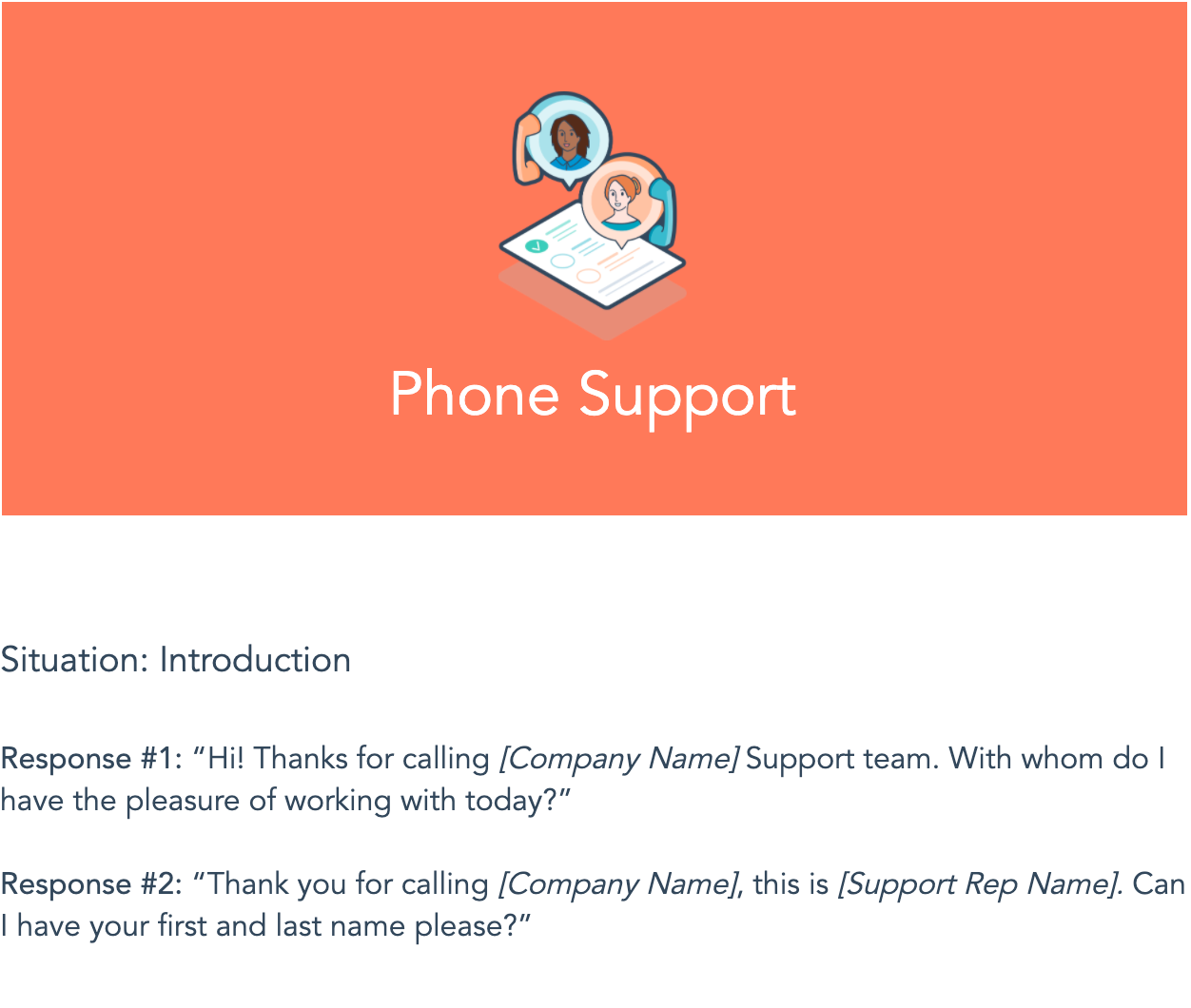Scripted.
For many, the word alone drums up memories of cheap “reality” television or empty political promises. And in a customer service or customer success context, the sentiment is similar.
Scripting — or in this case, positive scripting — is a controversial practice in the customer experience space. Some argue that it brings a level of consistency to the interaction, while others think it leaves a bad taste in customers’ mouths.
Below, we’ll dive in a little deeper to uncover what positive scripting really is, whether or not it works, and what to make of it.
What Is Positive Scripting?
Positive scripting is the process of mapping out predetermined responses or phrases intended to limit the customer’s frustration and keep the interaction productive.
You might be wondering, “does this actually work?”
Research from the 2020 National Customer Rage Study revealed that one of the primary factors of the all-time-high customer rage experienced in 2020 can be attributed to customer service reps who use phony, scripted answers. The study also reported that brand loyalty is associated with the satisfactory handling of customer complaints.
A 2018 study from Software Advice about call center scripts revealed that customer’s experience with a service rep improves when it doesn’t sound like they’re using a script.
Yikes.
Okay, so it’s clear that customers aren’t into the idea of having a conversation with a human robot, but does that mean there’s no room for positive scripting and scripting exercises in your approach to customer success?
Not entirely.
Benefits of Positive Scripting
When a customer is feeling frustrated, it can be hard to find the right words to keep the conversation on track — especially for folks that are new in a customer-facing role. That’s where positive scripting comes in handy.
Positive customer scripts ensure you’re never left grasping for words when a difficult situation arises. Instead, you’ll feel confident in creating a consistent, cohesive customer service experience.
When it comes to transactional requests, scripts can be used to streamline communication and help you quickly get the customer what they need.
Negative Aspects of Positive Scripting
As noted by the survey results above, you’re not pulling the wool over your customers’ eyes when you read from a script. In most cases, the customer can tell when an interaction is scripted.
In fact, according to the same Software Advice study cited above, using a customer’s name — a common tactic used in call scripts — doesn’t actually make the customer feel respected. And this is just one of many strategies that falls flat once the customer realizes they’re just being fed a script in response to their inquiry.
It’s also worth noting that leaning on a script too heavily signals to the customer that the person they’re speaking with isn’t confident in their ability to help — or isn’t qualified to do so. These red flags alone are enough to start a service interaction on the wrong foot.
Best Practices for Positive Scripting for Customer Service
1. Do: Use scripts as a training tool.
If you or someone on your team is new to the role, positive scripting can be an incredibly useful training tool. Scripts serve as a starting point, helping new service or success professionals learn the ropes and better understand the flow of positive customer interaction.
But even at this early stage, scripts should be used lightly. To prevent dependency, you might provide general bullet points instead of a long, phrase-by-phrase document. This ensures that the person has enough knowledge about the product and business to provide an accurate, helpful solution using their own words.
2. Don’t: Forget that you’re talking to a person.
In many cases, customer interactions take place via telephone, live chat, email, or social media. In these instances, it’s important that you don’t lose sight of who you’re communicating with – even when you can’t see them.
So before you turn to that list of canned responses, take a moment to ask yourself, “Would I say this to a customer’s face?”
Think about it: What sounds more natural to you?
- “It’s our policy to take down this information before we get started. I understand how you feel, but that’s all we can do.”
Or,
- “Here’s what I can do to make this easier for you. Let’s start by taking some information down.”
Notice the difference? The second response feels more personal. At its core, it communicates the same message as the first response – but it’s much more human.
If your goal is to create resonance with a customer, don’t hesitate to improvise.
3. Do: Talk to senior management about reducing restrictive scripts.
If scripts are being enforced by senior management, you shouldn’t shy away from raising some concerns.
Typically, those in charge of a customer success or service department will put scripts in place as a way to streamline communication. Again, this is fine in a training environment but can be limiting when it comes to carrying out customer interactions across all touchpoints.
According to an annual shareholder letter from Jeff Bezos, companies should be focused on customer outcomes, not just processes. Because when you pour all of your energy into the process, you’re no longer focusing on the end result — customer satisfaction. You become so involved in doing it right that you end up missing the mark.
If you’re feeling limited by scripts and canned responses, start a conversation with leadership about the benefits of having more agile conversations with customers — just be sure to come prepared with solutions, rather than a list of complaints.
4. Don’t: Let scripting get in the way of true empathy.
“You can’t script empathy,” explains customer experience expert Bruce Temkin.
“The right way to do it is to teach the agents about why you’re trying to show empathy — what it is — and why it is important.”
And Temkin has a good point: Creating a positive customer experience relies heavily on your ability to connect with your customers and establish common ground. This type of relationship calls for listening, understanding, and communicating real empathy.
So when you sense frustration or confusion from a customer, ditch the script entirely. Put yourself in their shoes and respond accordingly.
At the end of the day, true sincerity trumps queuing up the perfect one-liner.
5. Do: Lean on positive words.
We mentioned earlier that positive scripting is used to keep unsteady customer interactions from going south, but in many cases, an entire script isn’t necessary.
Rather than filling the conversation with a bunch of affirmative comebacks and quips (read: robotic jargon), try leaning on a few powerful, positive words instead.
“Customers don’t care about your policies. Find and engage the need. Tell the customer what you can do.” – Alice Sesay Pope
Need inspiration? Here are a few suggested words to pull in when you need to inspire confidence:
|
|
Remember: Use these terms wisely. Over-use of positive words can come off as disingenuous.
Positive Scripting for More Authentic Customer Communication
LiveChat’s Olga Kolodynska explains: “Having standards and procedures have many benefits in terms of quality control and developing a consistent customer experience. Yet, companies need [to] assess the value of consistency versus the advantages of allowing or promoting a more human, personalized customer service conversation.”
When it comes to positive scripting, we’d argue that this perspective is spot on. While quality and consistency are critical measures of customer experience, it’s possible to achieve success in these areas without scripting all of your interactions.
A solid first step? Empowering those in customer-facing roles to make decisions, improvise, and use good judgment.
Customer Service Script Template
Customer service scripts can be used for a good purpose. But, the key is to take a positive approach to each customer interaction and know when to ditch the script.
Below are a few of the most natural scripts for customer service teams. They’re customizable so you can adjust them for your personality and your company’s brand.
45 Free Customer Service Script Templates
1. Phone Support
If you take most of your support inquiries via phone calls, you’ll find this phone support script template quite beneficial. It covers common activities that occur onsupport calls like making introductions, placing a customer on hold, transferring calls, and more.
2. Email Support
Similar to live chat, email is text-based which makes it difficult to convey genuine, empathetic support to customers. These templates give you thoughtful, helpful responses to customer issues that feel both sincere and authentic.
3. Live Chat Support
Supporting customers via live chat comes with its own distinct challenges. You don’t have the luxury of using your voice to communicate empathy, and it’s tougher to get a sense of your customer’s mood. And, live chat support must be quick, so you can’t spend too much time wordsmithing your responses to customers.
Use this live chat support template to keep your responses quick and helpful during every customer interaction.
4. Social Media Support
Omni channel experiences are becoming more popular — customers aren’t limiting their inquiries to phone calls or support emails.
Now, they’re going to social media for customer support. So, whether your marketing team disseminates inquiries to the customer service team or they handle these questions themselves, both teams will benefit from this social media support template. It covers, transferring the customer to the support team and responding to negative feedback.
5. In-Person Support
If you work in a setting where you have face-to-face contact with customers, you’ll want to print this template and keep it nearby. “Can I speak to the manager?” is a go-to phrase for many customers, but you don’t want to be that service rep who calls them in for every complaint.
These templates help you refocus the conversation so you can recommend a solution — preferably one that doesn’t involve your manager.
Empathetic Customer Services Starts with Positive Language
Framing customer issues in positive language doesn’t mean ignoring their needs. Positive scripting is actually much more helpful to the customer than rattling off solutions on the fly. With careful responses that sound natural and lead with empathy, your customers will never know you have a script in front of you.
Editor’s note: This post was originally published in April 2020 and has been updated for comprehensiveness.


